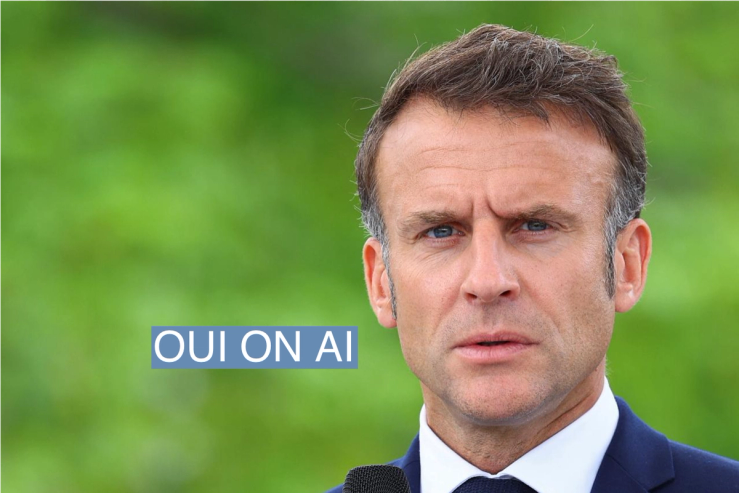The Scene
France’s high price of electricity could temper its surprisingly hot AI boom.
Paris has become a major player in the growing industry, aided by generous tax credits that help startups pay for expensive compute power. But the terms of those incentives might threaten its status.
Besides homegrown powerhouse Mistral, some US-based firms such as Poolside and Raive have moved to France or opened up offices there to take advantage of the country’s math talent, which is helpful in advancing complex AI architectures, and its tax benefits. It’s now home to about 600 AI startups, according to France Digitale, and French President Emmanuel Macron praised the industry last week, saying it would help Europe compete against China and the US.
The main subsidy that benefits tech companies is called the Crédit d’Impôt Recherche, or the research tax credit, which offers incentives ranging from 30% to 60% of R&D expenses, including employee salaries. The subsidies also effectively cover the first-year salary of PhD students after they graduate, if they work in R&D.
By most measures, the R&D tax credit has been a huge success. For about €6.5 billion in annual cost as of 2018, the French government estimates it will, in the long run, add 0.8% to the country’s GDP and create 60,000 jobs.
But a major gray area covers one of the biggest, if not the biggest, expense of many AI companies, which is the training of AI models with costly and powerful GPUs. If a company buys GPUs for R&D purposes, it gets a 60% tax credit. If they rent the GPUs from a cloud provider, the subsidy doesn’t apply, tax experts say.
But buying the GPUs and receiving the tax credit isn’t so simple. That’s because vague language in the measure makes it unclear whether those GPUs have to stay in France, where electricity costs are prohibitively expensive to train AI models, a task that needs a lot of energy.
Ultimately, the parliament would have to decide on whether and how to clarify the rules, but nothing has been finalized, according to French officials.
That leaves startups weighing whether the tax credits, which one venture capitalist noted were so valuable that they amounted to another funding round, are worth incurring high electricity expenses.
Some startups and advisors to French companies say that the law as it is written should cover the costs of training AI models, no matter who owns the GPUs or where they are located.
The AI startup Mistral, which has become a kind of symbol of the AI renaissance happening there, has chosen to train its AI models with cloud providers outside the country. That includes Microsoft, which inked a partnership with Mistral earlier this year to provide supercomputing infrastructure.
Two people with knowledge of the matter said Mistral’s decision to use outside compute resources, rather than build its own infrastructure inside France, was at least partly due to tax policy. Mistral did not respond to a request for comment.
Microsoft earlier this week announced that it was investing €4 billion in cloud and AI infrastructure in France, bringing up to 25,000 of the most advanced GPUs to the country by the end of 2025. A Microsoft spokesman said it won’t receive tax subsidies for the investment.
Know More
The CIR was reformed in 2008 to allow higher eligible expenditures, increasing costs for the French government from €1.8 billion in 2007 to €6.5 billion in 2018. Despite studies showing that the changes created new jobs and boosted the country’s GDP, critics in France have argued that the subsidies benefit large companies instead of smaller, more innovative businesses.
At the same time, France is spinning up new initiatives aimed at bolstering the AI ecosystem. The second phase of its National Strategy for AI, first launched in 2018, aims to boost infrastructure and fund academic research.
The government-funded Jean Zay supercomputer can be used by AI researchers, including startups, for free.
And some of France’s wealthiest business leaders have been pushing AI development. Billionaire Xavier Niel, founder of telecom provider Iliad, has pledged to invest $212 million in AI research. And Iliad’s cloud arm, Scaleway, is ramping up GPU-powered data centers for AI workloads.
Niel and shipping magnate Rodolphe Saadé are both investors in Mistral. And at the buzzy AI-Pulse conference in Paris last year, the two announced, along with former Google Chairman Eric Schmidt, a €300 million investment in a new AI research lab in France called Kyutai.
Step Back
France has long been a powerhouse when it comes to developing talent in the tech space. It helped make France an early pioneer of the internet. Minitel, which launched in 1982 and was distributed by state-owned France Telecom, was a wildly popular, commercially successful online service long before the worldwide web.
But the private sector approach to the consumer internet, favored by Silicon Valley, eventually won out, and much of France’s tech talent came to California and other places to start companies.
Another issue for France’s tech scene is that it isn’t the most inviting place for non-French speakers. It’s very common for people in the global tech industry to speak English, which makes moving to Silicon Valley easier.
One venture capitalist in Paris told Semafor that he holds all of his tech meetups in English, in hopes of making non-French participants feel more welcome.
Reed’s view
The most informative conversation I had on this topic was with a startup founder who was both proud of France’s tech ecosystem and partly convinced that his country would blow another opportunity to lead in the industry.
If France offered tax credits for the cost of training AI models, whether the training occurs inside France or not, and whether the company owns the GPUs or not, the long term benefit would be enormous. Those subsidies could also include electricity costs for running those GPUs.
That one change in the CIR would be a final ingredient in an already potent mixture that is making France an attractive place for AI startups from all over the world.
If the opposition to these subsidies is about the cost, it’s shortsighted. The wealth creation that is about to happen in the AI industry is potentially bigger than the internet. Any money governments spend to attract this industry will likely be paid back exponentially.
It’s not enough to simply hold on to existing talent. France needs to attract new talent in order to surge ahead. It doesn’t have the melting pot, land of opportunity image that attracts people to the US. Tax subsidies are probably the easiest route to achieving that goal.
Another thing working in France’s favor is that the US is suffering from self-inflicted wounds. Discord over immigration policies, toxic politics and frightening mass shootings all work against its efforts. Granted, France has its own immigration hurdles.
Room for Disagreement
The nature of new AI startups is that they have much higher R&D costs compared to tech startups in the past, thanks to the compute costs of AI. That may make it difficult to evaluate objectively the effectiveness of the tax credits. One measure used in the past was patents generated per dollar spent on tax credits.
French economist Philippe Aghion has researched how, when R&D tax credits are given to smaller companies, they lead to a higher number of patents filed compared to when subsidies are given to larger companies. “While the research tax credit (CIR) should no doubt be maintained to subsidize R&D costs, it should be aimed more particularly at small and medium-sized enterprises, which tend to be the most innovative,” he said in an interview.
Notable
- Cedric Villani, a French Fields Medal winner, was the architect of the country’s artificial intelligence strategy, launched in 2018. Bloomberg profiled him back then.


